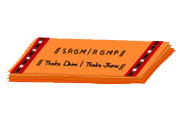Lyrics and Meanings (Javali)
The word "Jāvaḷi" is derived from the Kannaḍa word "Jāvaḍi" which means lewd poetry. The jāvaḷi came into existence in the nineteenth century.view more
Lyrics and Meanings (Javali)
The word "Jāvaḷi" is derived from the Kannaḍa word "Jāvaḍi" which means lewd poetry. The jāvaḷi came into existence in the nineteenth century. While Padham is dignified and deals mostly with love for god / love of god, the Jāvaḷi is a much lighter form and is erotic in nature. The themes revolve around human relationships and are very sensuous. The tunes are light, catchy and appealing owing to which the Javalis are popular. The language is colloquial. The music in Jāvaḷi sis lighter, the language is colloquial and a lot of humor and satire is employed.
Padhams and Jāvaḷi are scholarly compositions in the classical genre on the theme of Śhrungāra Rasa, depicting the Nāyaka Nāyaki bhāva. Padhams are dignified compositions, describing Madhhura Bhakthi, sung in slow tempo which requires immense skill and expertise to master. Jāvaḷis are dazzling pieces which are sung in a faster tempo.
Padhams and Jāvaḷi are performed in the second half of a dance concert. Jāvaḷis treat love in a lighthearted manner. The poetry and the music selected are catchy. As Padhams, Jāvaḷi too are love songs. Jāvaḷi are sung mostly in the Nāyaka, Nāyaki and Sakhi bhāvas. Jāvaḷi talk of love that is worldly and human. In the poetry one will find the character craving for the love of a person full of human and worldly desires and motives. While dealing with human relationships, sometimes the Jāvaḷis contain contents of sensuous and erotic nature.
| 1 | Māthāḍa Bāradhéno (Kannada) | click here |
| 2 | Marubāri Thālalénura (Thelugu) | click here |












